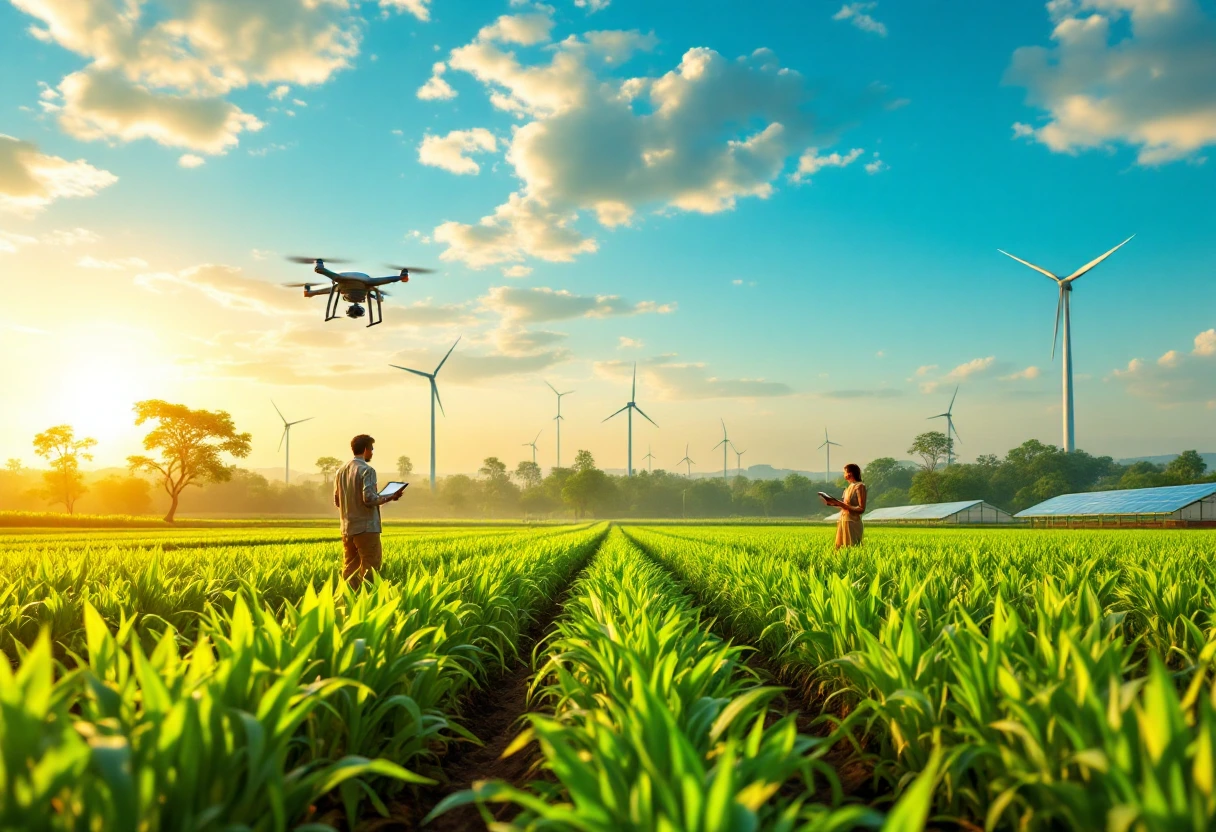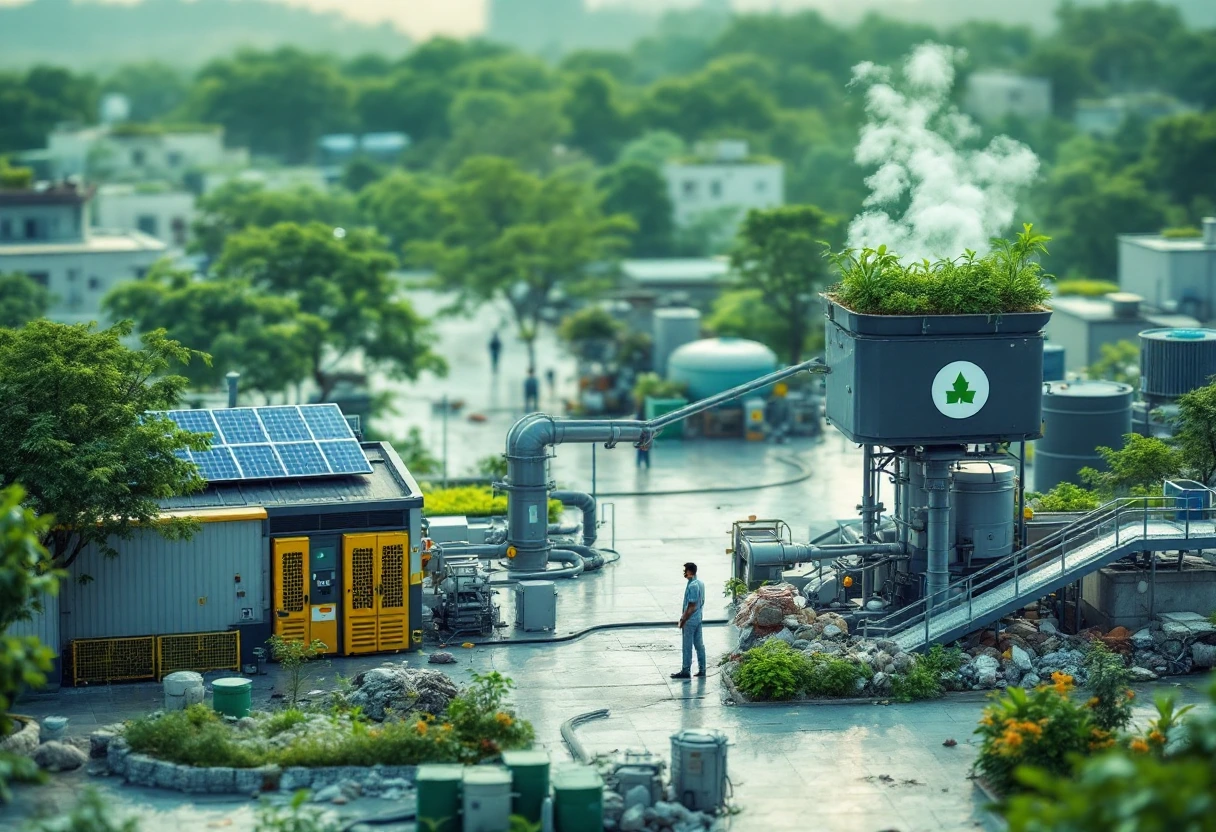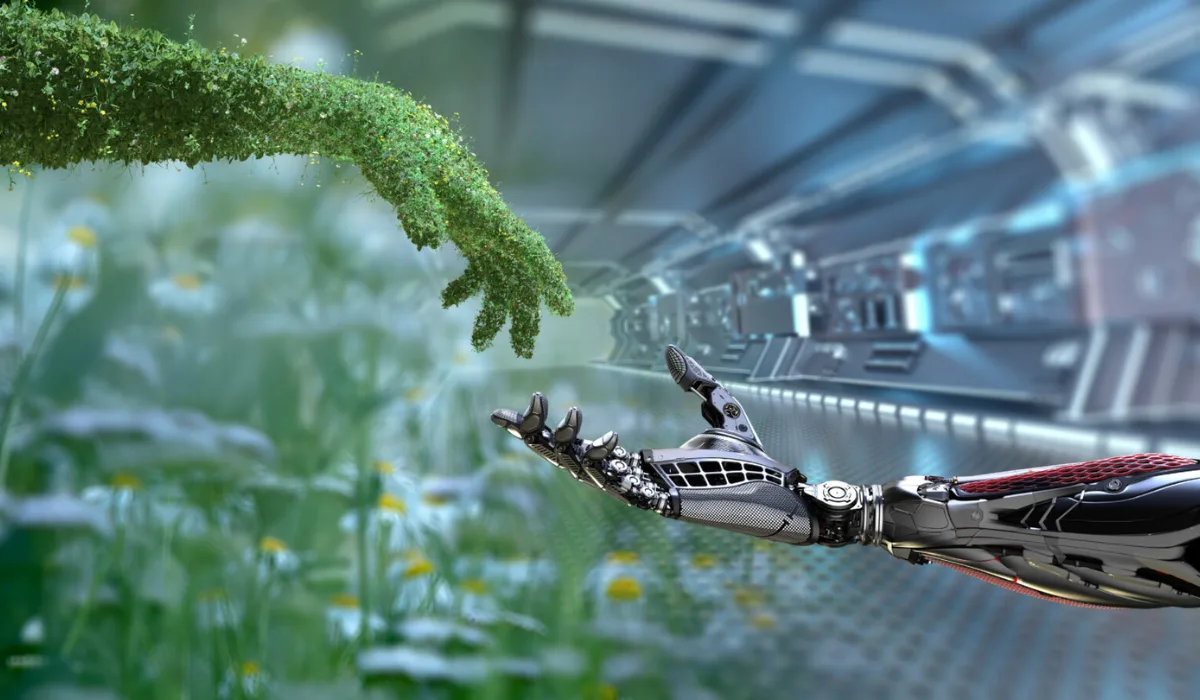Have you ever thought about how crops in India is changing? Following the incredible expansion of agricultural technology in India, I am eager to share what I have found out. New green technology is quickly changing how farmers produce our food, and India is at the centre of this change!
How Indian Greentech Is Transforming Agriculture Today
Drones flying over fields and farmers using cellphones to monitor soil health astonished me when I visited rural Maharashtra farms last year. This isn't the farming my grandparents were familiar with! In just a few years, farming equipment in India has grown greatly. Dealing with climate change and water constraints, India struggles greatly to feed its expanding population. Indian greentech solutions are therefore rather crucial as they enable farmers to produce more food while conserving the environment.
The Agriculture Revolution in India Is Happening Now
The agriculture revolution in India is changing how millions of farmers work. Old farming ways are meeting new technology, creating something special.
I recall speaking with Rajesh, a Punjab farmer, who said, "These new equipment have altered everything for me. I cultivate more crops than ever before, use less water and less pesticides.
Here's what makes this revolution so exciting:
- Farmers are using smartphones to get weather updates and crop prices
- Solar-powered irrigation systems help save water and energy
- AI and data analytics help decide when to plant and harvest
- Agriculture technology companies in India are creating solutions specifically for local needs
Understanding the Growth of Agriculture Technology Companies in India
When I researched the market, I found that agriculture technology companies in India have grown by more than 25% each year since 2018. These companies are solving real problems that Indian farmers face. Big companies and small startups are working on everything from soil testing kits to farm management apps. Many of these businesses were started by people who grew up in farming families and understand the challenges firsthand.
Some popular agriculture tech startups include:
- CropIn - helps farmers track crop health using satellites and AI
- DeHaat - connects farmers to supplies, advice, and markets
- Fasal - provides detailed weather insights and irrigation advice
- Agricx - uses AI to grade and quality-check produce
Read also: Latest Indian Greentech Products For Home Use
Smart Farming: The Future Is Already Here
Smart farming uses technology to make farming more accurate and efficient. I've seen how this works in real farms across India, and it's impressive!
How Digital Tools Are Changing Farming Forever
Remember when farmers had to guess when to water crops or how much fertilizer to use? Those days are ending. Now, digital agriculture tools give exact information. I spoke with farmers using soil sensors sending moisture data to their mobile devices. They know precisely when to water—not too much, nor too little. It helps crops grow better and saves water.
Digital farming in India is growing fast because:
- Cheaper smartphones mean more farmers can use farming apps
- Better internet coverage in rural areas connects more farms
- Solar power provides electricity for tech tools even in remote places
- Young farmers are comfortable using new technology
Water-Saving Technologies Making a Difference
Water is precious in India, especially with changing rainfall patterns. I've seen firsthand how water conservation technology is making farming possible even in drought-prone areas.
Some amazing water-saving technologies include:
- Drip irrigation systems providing water straight to plant roots
- Soil moisture sensors that stop overwatering
- Structures for water collection that trap rainfall for future usage
- Smart irrigation systems that change watering depending on weather forecasts
Kavita, a farmer I met in Karnataka, said, "I could only cultivate one crop a year before employing drip irrigation. I now cultivate three distinct veggies and my revenue has increased double.
Solar-Powered Farming Solutions Taking Root
The sun that grows crops can also power farming equipment! Solar energy in agriculture is changing how farms work. I went to a Gujarat farm run by solar-powered pumps rather than diesel ones. The farmer didn't have to bother about fuel shortages and saved money. And no noise or pollution!
Some popular solar farming solutions include:
- Solar water pumps for irrigation
- Solar dryers for preserving fruits and vegetables
- Solar cold storage units that keep produce fresh longer
- Solar fencing to protect crops from animals
Precision Agriculture: Getting It Just Right
Precision agriculture involves providing crops with exactly what they need, when and when they need it. It's like tailored focus for every field part!
How Soil Health Monitoring Is Changing the Game
Healthy soil means healthy plants. Modern soil testing technology helps farmers understand exactly what their soil needs. I watched farmers in Telangana use simple soil testing kits that give results in minutes. They know if they need to add nutrients or change the soil pH, making better decisions for their crops.
Some soil health technologies include:
- Portable soil testing kits that farmers can use themselves
- Soil health cards provided by government programs
- Remote soil analysis using satellite data
- Microbial treatments that improve soil naturally
Drones and Satellites: Farming from Above
The first time I seen a drone spraying pesticides on a rice field, I was struck at how quick and exact it was! Especially on bigger farms, agricultural drones in India are growingly common.
Drones and satellites help farmers:
- Map their fields accurately
- Spot crop diseases before they spread
- Apply treatments only where needed
- Monitor crop growth throughout the season
This technology saves time, reduces chemical use, and helps farmers act quickly when problems appear.
AI and Machine Learning in Crop Management
Though it's currently operating on Indian fields, artificial intelligence in agriculture seems futuristic. AI helps predict problems and suggest solutions.
I spoke with developers who created an app that can identify plant diseases from phone photos. Farmers take a picture of a sick plant, and the app tells them what's wrong and how to treat it.
AI tools help with:
- Disease detection before outbreaks spread
- Yield prediction to help with planning
- Pest alerts based on weather conditions
- Harvest timing recommendations for best quality
Read also: Indian Greentech Innovations For Clean Water
Mobile Solutions for Small Farmers
Most Indian farmers have small lands, and big machinery isn't practical for them. That's why mobile farming technology that works through phones is so important.
Farm Management Apps Changing Rural Life
Farm management apps are like having an expert in your pocket. I've downloaded several of these apps myself to understand how they work, and they're surprisingly easy to use.
These apps help farmers:
- Track expenses and income
- Record farming activities
- Get customized farming advice
- Plan crop rotations and planting times
Ramu, a small farmer from Andhra Pradesh, told me, "Before using this app, I kept forgetting when I applied fertilizer. Now I have all records on my phone and can make better plans."
Weather Prediction Tools Saving Crops
Weather can make or break a harvest. Weather forecasting technology gives farmers the information they need to protect their crops.
I was impressed when a farmer showed me how his app predicted a hailstorm three days in advance. He covered his vegetables with nets and saved his crop while others lost theirs.
Modern weather tools provide:
- Short-term forecasts for daily planning
- Seasonal outlooks for crop selection
- Extreme weather alerts for protection measures
- Historical weather data for better planning
Direct-to-Consumer Platforms Cutting Out Middlemen
Technology is also changing how farmers sell their crops. Agricultural marketing platforms connect farmers directly with buyers.
I've ordered vegetables directly from farmers using apps like Crofarm and Fresh From Farm. The farmers get better prices, and I get fresher produce!
These platforms offer:
- Better prices for farmers
- Quality produce for consumers
- Reduced food waste
- Transparent pricing
Overcoming Agriculture Technology Challenges in India
There are still obstacles to be tackled even with all the growth. In rural India, adopting technology for farming is not always simple.
Bridging the Digital Divide in Rural Areas
Not all farmers have smartphones or internet access. I've seen how digital literacy programs are helping bridge this gap.
Organizations are setting up training centers where farmers learn to use technology. Some even provide shared devices for those who can't afford their own.
Solutions include:
- Community technology centers in villages
- Voice-based services that work on basic phones
- Local tech helpers who assist less tech-savvy farmers
- Simplified interfaces designed for new users
Making Technology Affordable for Small Farmers
Many small farmers can't afford expensive technology. That's why affordable agriculture technology is so important.
I was excited to learn about pay-per-use models where farmers don't need to buy equipment. Instead, they can rent drones or soil testing services when needed.
Some approaches to make technology affordable:
- Government subsidies for green technology
- Farmer cooperatives sharing technology costs
- Rent-to-own models for equipment
- Microfinance specifically for farm technology
Government Initiatives Supporting Greentech Adoption
The Indian government has launched several programs to support agriculture technology governance. These help more farmers benefit from new technology.
When I researched government programs, I found impressive initiatives like the Digital Agriculture Mission and PM-KISAN that help farmers access technology.
Key government initiatives include:
- Digital Agriculture Mission promoting technology use
- Soil Health Card Scheme providing soil testing
- Kisan Credit Cards making financing easier
- Agricultural Technology Management Agency providing training
Success Stories: Real Farms, Real Results
The best way to understand the impact of agriculture revolution in India is through real stories of farmers using these technologies.
Small Farmers Seeing Big Returns
Many assume technology only helps big farms, but I've seen how even one-acre farmers benefit enormously.
Lakshmi, a farmer with just two acres in Tamil Nadu, told me, "Since I started using the drip irrigation system and soil testing, my vegetable yields have increased by 40%. My children can now go to good schools."
Small farmers are seeing benefits like:
- Higher crop yields
- Better crop quality
- Reduced water and input costs
- More consistent harvests despite weather changes
Read also: How To Invest In Indian Greentech Companies
Organic Farming Getting a Tech Boost
Organic farming technology is helping farmers grow chemical-free food more efficiently.
I visited an organic farm using beneficial insects identified by AI to control pests. The farmer used natural predators instead of pesticides, growing premium organic produce that sells for top prices.
Technology is helping organic farmers with:
- Biological pest control identification and application
- Organic certification tracking and compliance
- Natural fertilizer optimization
- Market connections to organic buyers
Women Farmers Leading Technology Adoption
I've been particularly inspired by women in agricultural technology who are often leading technology adoption in their communities. Sunita from Rajasthan showed me how she uses a farm management app to run her entire operation. She told me, "Men in my village didn't think women could use this technology. Now they come to me for advice!"
Women farmers are:
- Forming tech training groups
- Creating support networks
- Often adopting new methods faster than male counterparts
- Using technology to balance farm work and household responsibilities
The Environmental Impact of Agricultural Technology
Beyond helping farmers, green agriculture practices are essential for protecting India's environment.
Reducing Chemical Use Through Smart Applications
Traditional farming often uses too many chemicals. I've seen how precision agriculture technology helps farmers use fewer chemicals while still protecting crops. Smart sprayers apply pesticides only where needed, sometimes reducing chemical use by up to 90%. This is better for the environment, safer for farmers, and saves money.
Benefits include:
- Less chemical runoff into water sources
- Healthier soil with more beneficial organisms
- Safer produce with fewer chemical residues
- Lower production costs for farmers
Conserving Water in a Changing Climate
With climate change affecting rainfall patterns, water conservation technology is more important than ever. I was amazed when a farmer showed me how his smart irrigation system used 60% less water than traditional methods. His crops still looked healthy and productive!
Water conservation technologies provide:
- Significant water savings
- More reliable crop production
- Protection against drought
- Sustainable farming for future generations
Reducing Carbon Footprints with Clean Energy
Agriculture contributes to climate change, but clean energy for agriculture can help reduce this impact. A farmer in Bihar proudly showed me his biogas plant that turns crop waste into cooking fuel and organic fertilizer. He's reducing emissions and creating valuable resources from what would be waste.
Clean energy solutions include:
- Solar-powered farm equipment
- Biogas from farm waste
- Wind energy for water pumping
- Energy-efficient processing equipment
The Future of Indian Agriculture Technology
What's coming next in this exciting field? I've talked with researchers and companies about the cutting-edge developments in future farming technology.
Emerging Technologies to Watch
Some technologies are just starting to appear on Indian farms but will become more common soon. I recently tested a smartphone app that uses AI to diagnose plant diseases with 95% accuracy. This technology will soon be available to millions of farmers.
Technologies to watch include:
- Blockchain for food traceability
- Vertical farming in urban areas
- Autonomous equipment that works without operators
- Gene editing for climate-resilient crops
Creating a Sustainable Food System
The ultimate goal of agricultural sustainability technology is to create a food system that can feed everyone while protecting the environment. During my research, I found that farms using integrated technology approaches can produce up to 50% more food with lower environmental impact.
A sustainable food system needs:
- Resource-efficient production methods
- Reduced food waste through better storage and processing
- Shorter supply chains connecting farmers and consumers
- Climate-resilient farming practices
Building the Skills for Tomorrow's Agriculture
As technology changes farming, agricultural education must also change to prepare farmers for the future. I visited an agricultural training center where young farmers learn to use drones, interpret soil test results, and manage digital farm records. These skills will be essential for successful farming.
Important skill areas include:
- Technical knowledge for using and maintaining equipment
- Data analysis for making smart farming decisions
- Digital literacy for accessing information and services
- Environmental management for sustainable practices
Conclusion: Growing Together with Technology
The agriculture revolution in India is just beginning. As more farmers adopt technology and more innovations appear, Indian agriculture will continue to transform. I'm optimistic about this future where farming is more productive, profitable, and sustainable. Technology isn't replacing farmers - it's empowering them to do more with less. If you're interested in learning more about agriculture technology in India, there are many resources available online. You can also visit agricultural universities and research centers that often hold demonstrations of new technologies.













